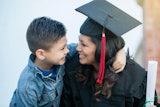College attendance has become less of a privilege and more of a necessity in the contemporary workforce. This cultural shift is a reflection of President Obama’s goal of having the largest percentage of college graduates out of all the countries in the world by 2020. With this push has come an influx of students that may not have been part of the college scene as early as a decade ago. Availability of courses online and expansion of options at the community college level have paved the way for non-traditional students to earn degrees and a better living. A growing demographic in college attendance and graduation is first-generation students.
More “firsts” than ever
A 2010 study by the Department of Education found that 50 percent of the college population is made up of first-generation students, or those whose parents did not receive education beyond a high school diploma. The National Center for Education Statistics released numbers in 2010 that broke down the educational levels of parents of current college attendees. Minority groups made up the largest demographics of students with parents that had a high school education or less, with 48.5 percent of Latino and Hispanic students and 45 percent of Black or African-American students included. The parents of students of Asian descent came in at 32 percent with a high school diploma or less, and Native Americans at 35 percent. Of students that identified themselves as Caucasian, only 28 percent were first-generation college students.
Though higher in minority groups, these numbers show the overarching trend of first-generation college attendance in all American demographics. While an education is viewed as an advantage in the job marketplace, the degree alone does not automatically lead to better opportunities and pay. In order to ensure optimal career success in the growing group of first-generation college students, the specific needs of these young people must be addressed — beyond what lies in textbooks.
Challenges facing first-generation students
The simple assumption is that a higher number of educated first-generation college students will translate to better jobs for these graduates and a better quality of life. The answer to the equation is just not that simple, however. Even with a college degree, first-generation students often come from low-income, minority or immigrant families and do not have the same set of life skills and personal capital of middle-to-high income bracket students.
Parents of first-generation students also do not have the life experience to adequately guide their children to the next step in succeeding in the college-educated workforce. A 2004 report in the Journal of Higher Education put it this way: “first-generation students … may be less prepared than similar students whose parents are highly educated, to make the kind of informed choices … that potentially maximize educational progression and benefits.”
The transition from a college setting to a full-time career is often bumpy for all college students, especially first-generation graduates. The things learned in a classroom simply cannot adequately translate to the real-world; in addition to “book smarts” colleges and universities have a responsibility to prepare attendees, particularly first-generation ones, for the challenges of the modern workforce.
What can be done
There are some federally funded programs in place to address the specific issues that face first-generation college students, like the TRIO and Robert McNair programs that lend academic and tutoring services to this group. The problem with these programs, and others like them, is that they are not required for college graduation and are vastly underutilized. A better approach is proactive mentorship and advising that mandates interaction between students and professors or other staff members that can provide real-world guidance. These programs would focus on the translation of knowledge to marketplace settings from people that know the ropes.
Colleges and universities should also place continued focus on developing skills and employability among students. Schools with especially high numbers of first-generation students, like California State University Dominquez Hills, have implemented workforce “101” courses to up the social and intellectual skills of future graduates. It is not enough to assume that students inherently know how to apply classroom skills to a real-world environment, particularly in the case of first-generation ones. Researching the needs of these students should be a priority of all institutions of higher education as it would help them form a better-prepared student body and strong workforce.















